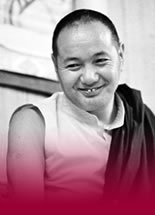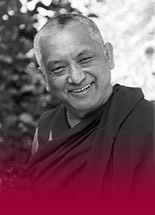Robina’s Blog
11 May, 2023
Buddha says that whatever exists necessarily exists in dependence upon various factors – causes, parts, and so on – and is therefore empty of existing from its own side: the two truths: dependent arising and emptiness. One of our biggest mistakes when we hear that things are empty, and it’s easy to make, is to assume they don’t exist; we fall into the abyss of the great mistake, as Tsongkhapa says. “Oh well, it’s all empty so nothing matters.”
But actually, emptiness doesn’t negate existence; it affirms it.
Buddha expresses it so nicely in the Heart Sutra. He tells us through the conversation between Shariputra and tenth-level bodhisattva Avalokiteshvara – he channels his thoughts into their minds while he’s sitting there in meditation; they do the talking – that emptiness and dependent arising come together; you can’t have one without the other.
Actually, I always like to think about how he was there “with a great host of monks and a great host of bodhisattvas,” but if you’ve been to Vulture Peak, you know it's a very tiny place, so where do they all sit, I often wondered. I asked Geshe Dakpa, our wonderful lama in San Francisco, and he said, “What do you think? In the sky, of course!”
So Shariputra says to Avalokiteshvara, how should any child of a good family who wishes to practice the perfection of wisdom, how should they practice? And Avalokiteshvara answers that “any son or daughter of a good family who wishes to understand the profound perfection of wisdom should look upon it like this,” that in emptiness there is no form, no feeling . . . and he lists the various categories of phenomena in the world according to Buddha’s view: first the five aggregates; then the eighteen constituents – the six senses, the six sense bases, the six sense objects; then the twelve links; the four noble truths, and so on.
But before he goes through the list, he takes the first of the five aggregates, the way that Buddha broke a person down into five components, and he says, “Form is empty. Emptiness is form. Form is nothing other than emptiness, and emptiness is nothing other than form.”
You can put anything in place of form: “Self is empty. Emptiness is self. Self is nothing other than emptiness, and emptiness is nothing other than self.”
What Buddha is telling us is that wherever you find the conventional self you will necessarily find, right there on the self, the emptiness of inherent self; that this absence of inherent self is a characteristic of the conventional self.
Emptiness and dependent arising: the two truths. You can’t have one without the other.
So, why is Buddha telling us that the self (and everything else) is empty of inherent existence in the first place? Because we totally believe the exact opposite: that there is a self in there somewhere, the boss, the bit that runs the show, independently of all the other bits.
The trouble is that because this belief is so deeply held in the bones of our being, as soon as we hear that this self is empty, we assume it doesn’t exist at all. We chuck the baby out with the bath water.
Buddha tells us that there isn’t an independent self in there, but it’s not enough to just believe him; we need to prove it. So we need to search for it. If we do the search properly we will indeed discover that there is no self in there. But we won’t discover nothingness.
When you expect tea in your cup and you lift the cup to drink from it but discover there’s no tea there, you’ll go, “Oh, my cup is empty!” Literally, it’s true that there is actually nothing in the cup, but that’s not what you cognize. What appears to your mind very vividly is the absence, the emptiness of what you expected there: your tea.
Nothingness is one thing and the absence of something is another, quite different, thing.
Same with the self. We won’t find a self in there among all the other parts, but we don’t discover nothingness. As His Holiness says, it’s not as if you chuck out all the bits in your search for the self and end up with nothing. No.
Instead, what we’ll find is the absence of what we thought was there: a special, shiny existing-in-and-of-itself self. That’s a very shocking, very vivid, delicious thing to discover!
For the greatest yogis, Lama Zopa Rinpoche says, this discovery brings such bliss.
And then we’ll discover subtle dependent arising: that the self is merely labeled. As Lama Zopa Rinpoche says, when we’ve finally realized the emptiness of the self, that there is not even an atom of self there, it’s as if there is no self – but there is. But what does exist is so subtle it’s as if it doesn’t exist.
The two truths, together.

